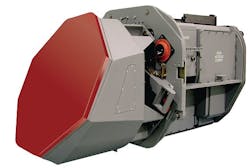Navy asks Boeing to update obsolescent electronic modules in F/A-18 AESA airborne radar
Officials of the Naval Air Systems Command at Patuxent River Naval Air Station, Md., announced plans this week to award a contract to the Boeing Defense, Space & Security segment in St. Louis to redesign several electronic modules in the AN/APG-79 airborne radar due to obsolescence issues.
The AN/APG-79 active electronically scanned array (AESA) radar is designed and manufactured by the Raytheon Co. Space and Airborne Systems segment in El Segundo, Calif.
The radar is for the Navy's F/A-18E/F Super Hornet fighter-bomber and EA-18G Growler carrier-based electronic warfare jet. It provides aircrew situational awareness, near-instantaneous track updates, and multi-target tracking capability.
The radar enables Super Hornet and Growler crews to fire several missiles at once and guide them to different targets that are widely spaced in azimuth, elevation, or range.
The APG-79 AESA radar uses transmit/receive (TR) modules populated with gallium arsenide (GaAs) monolithic microwave integrated circuits (MMICs). Presumable these are some of the electronic modules that Boeing experts will modify with updated electronics to mitigate obsolescence issues.
Component obsolescence, particularly in advanced military electronics, complicates maintenance and technology insertion, and increases the costs of keeping subsystems in tip-top shape because obsolete components are difficult to fine, and once located can be expensive to buy.
The APG-79 radar has an open-systems architecture and rugged commercial-off-the-shelf (R-COTS) parts. Its array has solid-state transmit and receive modules for enhanced reliability, as well as an advanced receiver/exciter, ruggedized R-COTS processor, and power supplies.
Related: Extending usable life in the face of obsolescence
Designing advanced electronics with R-COTS parts offers big advantages in speeding the availability of new-generation components for technology insertion, as well as ease of design and affordability. An issue with R-COTS designs, however, is the need to update systems more often than custom and mil-spec designs.
Making the problem worse is the threat of substandard counterfeit replacement parts, which can find their way into military systems if technicians cannot find suitable parts from authorized sources at prices they can afford.
The APG-79 AESA radar system, which is in production for the U.S. Navy and Royal Australian Air Force, has become one of the most important enabling technologies for bomber and electronic warfare jets.
Related: Video: R-COTS the right direction for redefining COTS, but still misses mark, panelists say
The radar's active electronic beam scanning helps steer the radar beam at nearly the speed of light to optimize situational awareness and air-to-air and air-to-surface capability, Raytheon officials say. The agile beam enables the multimode radar to interleave in near-real time, so that pilot and crew can use both modes simultaneously.
Navy officials say the plan to award the radar obsolescence-mitigation contract to Boeing sole-source because only Boeing has the knowledge, experience, and technical data necessary to do the job within the time required.
Boeing is the prime contractor for the F/A-18E/F Super Hornet and EA-18G Growler electronic warfare jet, and subcontracts to Raytheon for the APG-79 radar system.
For more information contact Boeing Defense, Space & Security online at www.boeing.com/boeing/bds, Raytheon Space and Airborne Systems at www.raytheon.com, or Naval Air Systems Command at www.navair.navy.mil
